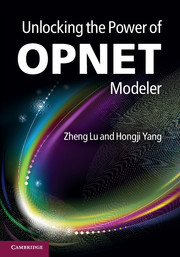Book contents
- Frontmatter
- Contents
- Preface
- List of abbreviations
- Part I Preparation for OPNET Modeling
- Part II Modeling Custom Networks and Protocols
- Part III Modeling and Modifying Standard Networks and Protocols
- Part IV OPNET Modeling Facilities
- 11 Debugging simulation
- 12 OPNET programming in C++
- 13 Traffic in OPNET simulation
- 14 External model access (EMA)
- 15 OPNET co-simulation with third-party programs
- 16 Model authoring and security
- References
- Index
13 - Traffic in OPNET simulation
from Part IV - OPNET Modeling Facilities
Published online by Cambridge University Press: 05 February 2012
- Frontmatter
- Contents
- Preface
- List of abbreviations
- Part I Preparation for OPNET Modeling
- Part II Modeling Custom Networks and Protocols
- Part III Modeling and Modifying Standard Networks and Protocols
- Part IV OPNET Modeling Facilities
- 11 Debugging simulation
- 12 OPNET programming in C++
- 13 Traffic in OPNET simulation
- 14 External model access (EMA)
- 15 OPNET co-simulation with third-party programs
- 16 Model authoring and security
- References
- Index
Summary
This chapter shows how to generate traffic in OPNET Modeler in different ways, including explicit traffic and background traffic. To follow this chapter, it is assumed that a reader knows the basic concepts and operations of OPNET modeling.
Introduction
In Chapters 8 and 9, we demonstrated how to generate traffic based on application and profile models. However, it is also possible to generate traffic based on the traffic characteristics (packet interarrival times and packet size distributions) rather than applications. The custom models demonstrated in Chapter 5 generate traffic in this way. You can generate traffic this way with standard models as well. Further, you can generate self-similar traffic, background traffic which is based on analytical model, and even hybrid traffic which combines both explicit traffic and background traffic.
From the perspective of simulation methodology, traffic in OPNET modeling can be categorized into two groups: explicit DES traffic and background traffic. Explicit traffic includes traffic based on application model, traffic based on traffic generation parameters, and self-similar traffic based on a raw packet generator (RPG) model. Background traffic includes traffic based on baseline load and traffic based on traffic flow. In the following sections, we will demonstrate how to generate these different types of traffic in OPNET Modeler.
Explicit traffic
Explicit traffic models traffic in a packet-by-packet basis. It models packet creation, transmission, queuing, and destruction explicitly through a discrete-event simulation process.
- Type
- Chapter
- Information
- Unlocking the Power of OPNET Modeler , pp. 194 - 206Publisher: Cambridge University PressPrint publication year: 2012



